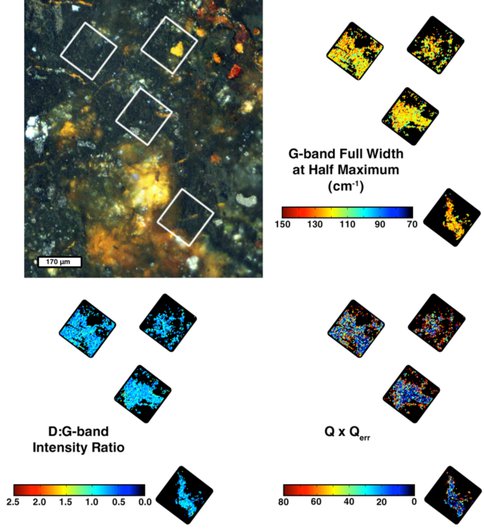2013 Annual Science Report
 University of Hawaii, Manoa
Reporting | SEP 2012 – AUG 2013
University of Hawaii, Manoa
Reporting | SEP 2012 – AUG 2013
The Nature and Timing of Aqueous Alteration in Ordinary and Carbonaceous Chondrites
Project Summary
Water plays a key role in the search for life and habitable planets outside of our Solar System. However, a fundamental question remains unanswered: what is the origin of water on Earth and the terrestrial planets? Our research addresses this question by looking towards chondrites, the building blocks of the Solar System. Chondritic meteorites were assembled within a few million years after the birth of the Sun, and preserve a record of the earliest Solar System processes. We are working to constrain the origin of water in chondritic asteroids, to understand the timescales and conditions of aqueous alteration on chondritic parent bodies, and the effects of aqueous alteration on synthesis and modification of organic matter in chondrites, and to explore how water affected the geologic evolution of primitive material. This work has important implications for the amount of water accreted or delivered to the inner Solar System planets, and the synthesis and delivery of organic matter necessary for life on Earth.
Project Progress
Nature and dating of aqueous alteration of ordinary and CV and CO carbonaceous chondrites
During last year, we studied the mineralogy, petrology, and Mn-Cr isotope systematics of aqueouslyaltered unequilibrated ordinary (UOC) and CV and CO carbonaceous chondrites. We showed that aqueous alteration of these meteorites occurred at low water/rock ratio (<0.2) and relatively high temperature (100−200°C). The alteration resulted in formation of various secondary minerals, including magnetite, phyllosilicates, fayalite, hedenbergite, and andradite. Fayalite (Fe2SiO4) has high Mn/Cr ratio and is suitable for dating aqueous alteration using 53Mn-53Cr isotope systematics (53Mn decays to 53Cr with a half-life of 3.7 Myr). To measure 53Mn-53Cr systematics of 5−10 µm-sized grains of fayalite in UOC and carbonaceous chondrites, we synthesized ferroan olivine standards with different fayalite content and developed an analytical protocol of Mn-Cr isotope measurements with the UH Cameca ims-1280 ion microprobe (Figs. 1−3). We showed fayalite in UOC, CV and CO chondrites formed in situ during aqueous alteration of their parent asteroids ~2, ~4 and ~5 Ma after formation of the Ca,Al-rich inclusions (CAIs) in CV chondrites (the oldest solids dated in the Solar System), respectively (Fig. 4). We showed that the previously published 53Mn-53Cr ages of fayalite formation are incorrect, because of the improper standards used for SIMS measurements (Fig. 3). Therefore, our results provide the first correct ages of aqueous alteration of UOC, CV and CO chondrites.
Nature and dating of aqueous alteration of CR and CM carbonaceous chondrites
The CR and CM carbonaceous chondrites experienced various degrees of aqueous alteration at high water/rock ratio (0.2−1) and relatively low temperature (<100°C). These meteorites avoided subsequent thermal metamorphism, and, therefore, represent ideal target for studying mineralogical, chemical and isotopic effects of aqueous alteration. The CR chondrites display a large range of aqueous alteration, from almost anhydrous (petrologic type 3.0) to nearly completely hydrated (petrologic type 1.0). Most CR chondrites experienced postalteration brecciation. To identify distinct CR lithologies, to study the effects of aqueous alteration on the bulk chondrite chemical compositions, and to identify minerals suitable for dating of the CR alteration, we have acquired false color x-ray maps of several CR chondrites using the scanning electron microscope and electron microprobe. In the Renazzo (CR2, fall) and GRO 95577 (CR1, Antarctic find) meteorites, we discovered calcite grains with high Mn/Cr ratio, and, therefore, suitable for 53Mn-53Cr isotope chronology.
We developed an analytical protocol for in-situ measurements of Mn-Cr isotope systematics of carbonates with the UH Cameca ims-1280 (Fig. 5). Since Mn-Cr isotope measurements in carbonates with SIMS require proper standards, we used calcite standard kindly provided by Dr. N. Sugiura (U. Tokyo). We have also given a significant effort to the development of better carbonate standards at UH (this work is in progress). We showed that there are multiple generations of carbonates in CR chondrites (Fig. 4), suggesting prolonged duration of aqueous alteration, and, possibly, different sources of heating of the CR asteroid (decays of 26Al and impacts). We are currently collaborating with Dr. A. Westphall (UC Berkeley) to unravel the cryptic composition of matrix materials in CR3 chondrites. Using the synchrotron at the UC Berkeley laboratory, we can investigate the oxidation state of iron in fine grained and amorphous material. This research may provide clues to the type of processing and extent of aqueous alteration of the primitive matrix.
We have also measured 53Mn-53Cr ages of carbonates in the extensively aqueously altered CM lithology of the recent chondritic fall, Sutter’s Mill. We showed that 53Mn-53Cr ages of dolomite in Sutter’s Mill are indistinguishable from those of carbonates in Renazzo and fayalite in UOC, CV and CO chondrites (Fig. 4). These observations indicate that aqueous alteration on several chondrite asteroids occurred almost contemporaneously.
We developed an automated system for digitizing high-resolution images of meteorite thin sections (Ogliore & Jilly 2012). This imaging system can serve as a sort of “digital microscope” to view thin sections from any computer.
Oxygen-isotope compositions of aqueously-formed minerals and sources of water in chondritic asteroids
To constrain possible sources of water on chondrite asteroids (inner vs. outer solar system), we measured in situ oxygen-isotope compositions of aqueously formed fayalite and magnetite in UOC and carbonaceous chondrites with the UH Cameca ims-1280. On a three-isotope oxygen diagram (d17O vs. d18O), compositions of fayalite and magnetite in UOC and CC, plot along mass-dependent fractionation lines with a slope of ~0.5 and D17O (=δ17O − 0.52× δ 18O) values of +4.5‰ and −1‰, respectively; they are in disequilibrium with bulk compositions of their host meteorites (Fig. 6a). Because D17O values of fayalite and magnetite are equal to D17O of a fluid, we infer that during formation of these minerals the fluid experienced insignificant exchange with 16O-enriched anhydrous silicates. In CMs and CIs, O-isotope compositions of carbonates and magnetite plot close to the terrestrial fractionation line (D17O ~ ±1.5‰); with increasing degree of aqueous alteration, and the D17O values of carbonates approach those of bulk meteorites (Fig. 6b). We suggest that D17O values of fayalite and magnetite in UOCs, CVs, and COs, and magnetite and carbonates in CIs and CMs, can be used as a proxy for D17O values of water ices that accreted into their parent asteroids.
In the CO self-shielding models of Yurimoto & Kuramoto (2004) and Lyons & Young (2005), water ice in the outer disk is highly-enriched in 17O and 18O relative to solids in the inner disk. This is consistent with heavy O-isotope compositions of iron oxides in Acfer 094 reported by Sakamoto et al. (2007). In contrast, the inferred D17O values of the chondrite water ices are close to the terrestrial value, i.e., very different from the suggested D17O values of water ices in the outer Solar System. We suggest that chondrite water ices had a local, inner Solar System origin, which is consistent with the inferred D/H ratio of chondritic water that is different from the isotopically heavy water in the Oort Cloud comets (Alexander et al. 2012).
Fluid-organic-mineral interaction in CR carbonaceous chondrites
The CR chondrites contain up to ~5% carbon, mainly in the form of graphitic carbon. To understand the effects of aqueous alteration experienced by CRs on the insoluble fraction of the organic material (IOM), we studied IOM in QUE 99177 (CR3), EET 92161 (CR2), and GRO 95577 (CR1) using in situ Raman spectroscopy and our newly developed Savitzky-Golay second derivative method for spectral analysis. We find that the bulk chemical composition of the IOM is close in composition to graphite, and the IOM is essentially unaltered by aqueous alteration experienced by CRs. Raman measurements show that the graphitic part of the IOM is compositionally the same in all CRs studied (Fig. 7). At the same time, Raman spectral mapping (Fig. 8) suggests that the spatial distribution of the IOM changes with extent of aqueous alteration. One possible explanation is that aqueous alteration is mechanically moving the IOM without changing its chemical structure (Gazda et al. 2013). We suggest that the IOM accreted as clumps into the CR parent body and was spread around evenly as the degree of alteration increases. Other workers (e.g., Peeters et al. 2012) have found clear evidence for clumps in QUE 99177, which appears to support our hypothesis.
To test our hypothesis, we will measure C and N isotopic compositions of IOM in CR chondrites with the UH Cameca ims-1280. Isotopic analysis could help to determine source (preaccretion) reservoir of the IOM in CRs and understand whether IOM was chemically changed with the extent of aqueous alteration. If our hypothesis is correct, the C-isotope compositions of IOM should show no correlation with degree of aqueous alteration of the host meteorite. Raman images (e.g., Fig. 8) will be combined with isotopic maps to be acquired with SIMS and would provide additional information on the relationship between spatial distribution and chemical composition of IOM in CR chondrites.
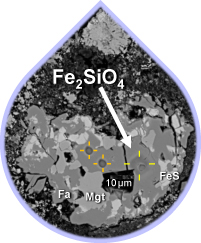
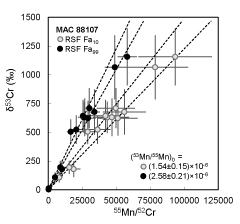
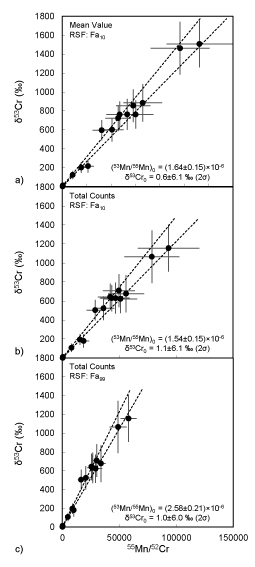
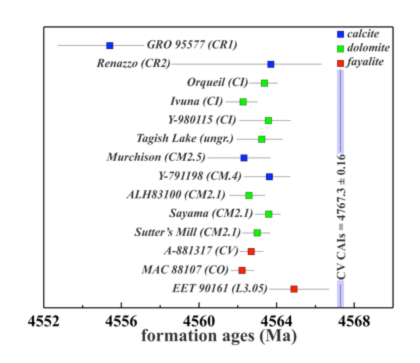
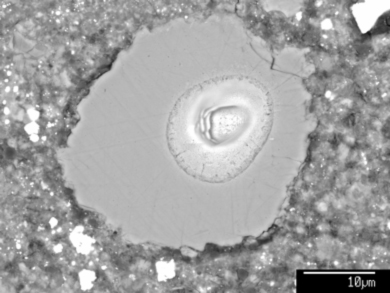
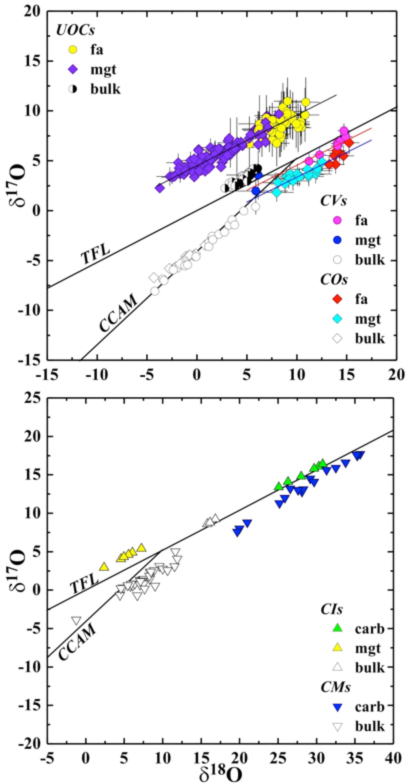
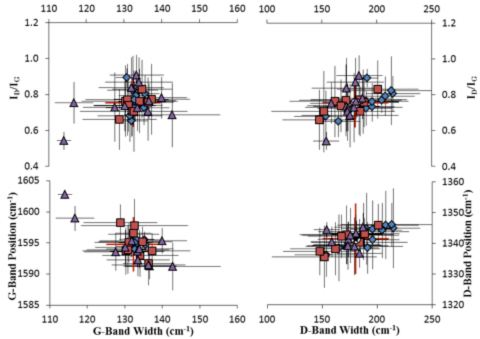
Publications
-
Jenniskens, P., Fries, M. D., Yin, Q-Z., Zolensky, M., Krot, A. N., Sandford, S. A., … Worden, S. P. (2012). Radar-Enabled Recovery of the Sutter’s Mill Meteorite, a Carbonaceous Chondrite Regolith Breccia. Science, 338(6114), 1583–1587. doi:10.1126/science.1227163
-
Jogo, K., Nagashima, K., Hutcheon, I. D., Krot, A. N., & Nakamura, T. (2012). Heavily metamorphosed clasts from the CV chondrite breccias Mokoia and Yamato-86009. Meteoritics & Planetary Science, 47(12), 2251–2268. doi:10.1111/maps.12042
-
Ogliore, R. C., & Jilly, C. E. (2013). Gigapixel optical microscopy for meteorite characterization. Planet Sci, 2(1), 3. doi:10.1186/2191-2521-2-3
- Brearley, A.J. & Krot, A.N. (2013). Metasomatism in the early solar system: The record from chondritic meteorites [Book Chapter]. Metasomatism and the Chemical Transformation of Rock – Lecture Notes in Earth System Sciences.
- Doyle, P.M., Krot, A.N. & Nagashima, K. (2013). Oxygen Isotopes of Fayalite, Magnetite and Chondrule Olivine in the CO (Y-81020, EET 90043) and CO-Like (MAC 88107) Chondrites. Meteoritics and Planetary Science supp, 76(5135).
- Gasda, P.J. & Ogliore, R.C. (2013). Modeling the Raman spectrum of graphitic material in rock samples with fluorescence backgrounds: Accuracy of fitting and uncertainty estimation. Applied Spectroscopy.
- Gasda, P.J. & Taylor, G.J. (2013). Chemical properties of the graphitic materials in CR carbonaceous chondrites: the effects of aqueous alteration. Geochimica et Cosmochimica Acta.
- Gasda, P.J., Taylor, G.J., Misra, A. & Sharma, S.K. (2012). Mapping Organic Materials in Carbonaceous chondrites. Meteoritics and Planetary Science, 75(5148).
- Jacobsen, B., Matzel, J.E., Doyle, P.M., Krot, A.N., Hutcheon, I.D. & Telus, M. (2013). New constraints on the timing of Fayalite formation in unequilibrated ordinary chondrites. Meteoritics and Planetary Science supp, 76(5348).
- Jilly, C.E. & Huss, G.R. (2012). Variation in solution pH during aqueous alteration of CR chondrites. Meteoritics and Planetary Science Supp, 74(5323).
- Jilly, C.E., Huss, G.R., Nagashima, K., Yin, Q-., Sugiura, N. & Krot, A.N. (2013). In situ radiometric dating of aqueously formed carbonates in Sutter’s Mill. Meteoritics & Planetary Science, 76(5303).
- Krot, A.N., Doyle, P.M., Nagashima, K., Jogo, K., Wakita, S., Ciesla, F.J. & Hutcheon, I.D. (2013). Origin of asteroidal water: Constraints from isotopic compositions of aqueously-formed minerals. Meteoritics and Planetary Science Supp, 76(5161).
- Krot, A.N., Doyle, P.M., Nagashima, K., Jogo, K., Wakita, S., Ciesla, F.J. & Hutcheon, I.D. (2013). Origin of water on the chondrite asteroids: Evidence from oxygen isotope compositions of aqueously formed minerals. Mineralogical Magazine, 77(5): 1515.
- Krot, A.N., Keil, K., Goodrich, C. & Weisberg, M.K. (2013). Classification of meteorites. In: Davis, A.M., Holland, H.D. & Turekian, K.K. (Eds.). Meteorites, Comets and Planets. Vol. Vol. 1 Treatise on Geochemistry. Elsevier: Oxford.
- Scott, E.R.D. & Krot, A.N. (2013). Chondrites and their components. In: Davis, A.M., Holland, H.D. & Turekian, K.K. (Eds.). Meteorites, Comets and Planets. Vol. Vol. 1, Treatise on Geochemistry. Oxford: Elsevier.
- Taylor, G.J., Scott, E.R.D., Huss, G.R., Krot, A.N. & Nagashima, K. (2012). Workshop on Formation of the first solids in the solar system. Meteoritics & Planetary Science, 47(1889).
-
PROJECT INVESTIGATORS:
-
PROJECT MEMBERS:
Gary Huss
Co-Investigator
Alexander Krot
Co-Investigator
Jeff Taylor
Co-Investigator
Patricia Doyle
Collaborator
Patrick Gasda
Collaborator
Lydia Hallis
Collaborator
Christine Jilly
Collaborator
Kazuhide Nagashima
Collaborator
Andrew Westphall
Collaborator
kaori jogo
Collaborator
-
RELATED OBJECTIVES:
Objective 1.1
Formation and evolution of habitable planets.
